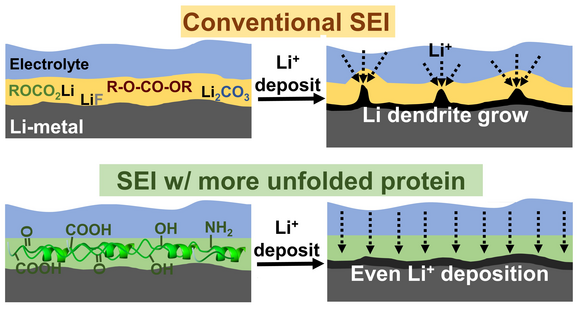Li-metal batteries (LMBs) have been the subject of several investigations aimed at creating safe and long-term cycling batteries. The transition of these very effective LMBs from lab to industrial scale manufacturing is still difficult.
 At the elevated temperature after protein-contained-electrolyte filling, the protein forms a functional-group-rich SEI on Li anode, building an even Li+ deposition during cycling. Image Credit: Journal of Energy Chemistry
At the elevated temperature after protein-contained-electrolyte filling, the protein forms a functional-group-rich SEI on Li anode, building an even Li+ deposition during cycling. Image Credit: Journal of Energy Chemistry
While the formation and evolution of the solid electrolyte interphase (SEI), through simulating the practical production process of LMBs, are rarely taken into consideration, most studies on LMBs are restricted to solving the problem of Li dendrite formation via an in situ or ex situ formed layer on the Li anode.
The Journal of Energy Chemistry has published a study by Chenxu Wang and colleagues (from Washington State University).
The production of protein-modified SEIs on Li anodes at various stand-still temperatures was reported by the scientists. Controlling the length of the stand-still procedure allowed researchers to look at how the protein-modified SEIs evolved.
By adjusting the stand-still process parameters, in particular, the development of the chemical components and the wetting behavior of the modified SEIs with an electrolyte were investigated. The simulation analysis supported the observation that the heat treatment for protein denaturation increased the amount of unfolded chain structures.
In comparison to the unheated sample, the resultant heat-treated-zein-modified (H-zein-modified) SEI showed improved wetting behavior and quicker SEI production (U-zein). Additionally, compared to the SEI with the U-zein modification (260 hours), the symmetrical Li|Li cell with the H-zein modification had a greater cycle life (360 hours).
In addition, after 200 cycles, the symmetrical LiFePO4/Li cell with the H-zein-modified SEI had a more consistent long-term cycling performance with better capacity retention (70%) than the cell with the U-zein-modified SEI.
Consequently, during a brief period of standstill, high and steady formation rates could be attained using the H-zein-modified SEI. In symmetrical Li|Li and complete cells, the H-zein-modified SEI on the Li anode enabled steady long-term cycling performance.
Journal Reference:
Wang, C., et al. (2022) Protein-modified SEI formation and evolution in Li metal batteries. Journal of Energy Chemistry. doi:10.1016/j.jechem.2022.06.017.